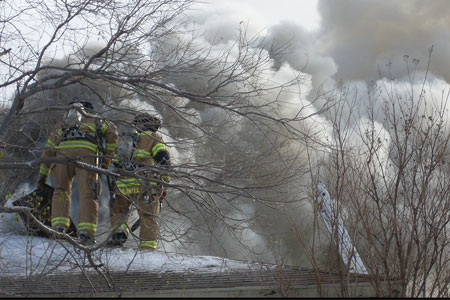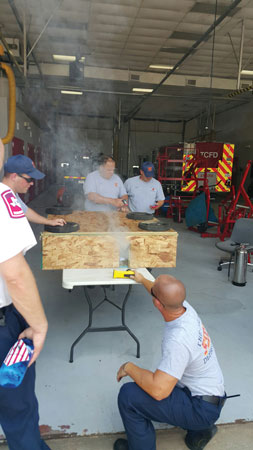
By J. Scott Thompson
In January 2014, The Colony (TX) Fire Department (TCFD) implemented operational changes that over time have proven effective for structural firefighting in TCFD. Among the changes was the integration of science-justified tactics. One year and 50 fire events later, fire operations in TCFD have been reviewed and revised based on actual experiences. To date, these science-based tactics have proven effective. As a result, TCFD has gained a much greater understanding of and confidence in the strategies, tactics, tasks, and techniques used to solve modern structural fire problems.
For the previous two years, the department had been actively positioning itself for tremendous growth and change. Although operational changes were already in the works, it was the Governors Island burns conducted by the Fire Department of New York, the National Institute of Standards and Technology, and Underwriters Laboratories that served as the catalyst behind the initiative to explore applying science to fire operations. At the time TCFD pulled the trigger on the initiative, very little had been written regarding interpretation of the data and applying it to the modern fireground.
The Colony Fire Department
The Colony has a population that just exceeds 40,000. It is part of one of the fastest growing regions in the country. Ninety percent of its buildings are post-1974. In early 2015, Nebraska Furniture Mart (The Mart) opened a 1.8-million-square-foot furniture retail and warehouse facility. With the opening of The Mart, the planning phase began for hotels, warehouses, and high-rise buildings. This alone has made it necessary for TCFD to embrace change. Additionally, the department had recently changed from the quint concept to an engine and truck deployment model with riding assignments and preassigned company tactics and tasks. This has proven to be very beneficial from a coordinated fire attack perspective.
TCFD is a career department that operates one engine, one quint, one tower ladder, two medics, and one battalion chief out of three stations. Minimum daily staffing is 14, with three firefighters assigned to engine companies and four to the tower ladder as staffing allows. Medics, when available, pair up with engine and truck companies on building fires to achieve four-person engine companies and a five-person truck. A typical box alarm for a reported building fire consists of four engines/quints, one truck, two medics, and two chief officers, bringing 22 firefighters to the scene.
The Process
Because existing operating guidelines were already in revision, the timing was perfect for including science-based information. The first phase of the process was to review the available data and conduct research on available information supporting what the data were indicating. As part of the department’s transition from the quint concept to designated engine and truck tactics and tasks, the pros and cons of positive-pressure fire attack and vertical ventilation were already being evaluated. This research complemented the data and observations from the Governors Island burns.
 |
| (1) Steam conversion immediately following effective vertical ventilation from an aggressive, coordinated, interior fire attack. (Photos courtesy of author.) |
Once an understanding of the data was gained and a vision for implementation established, the focus turned to figuring out how to incorporate the data into TCFD practices to enhance the new operating guidelines. Keep in mind there were no acronyms or articles specific to what we were hoping to accomplish. However, the research did indicate that much of what was being reviewed had been used in the fire service for years; it just had not been proven. What was new was that science-based data were disproving myths and fresh information was being presented for consideration for application on the fireground.
The second phase of the implementation process was to evaluate how the inclusion of science-based firefighting tactics and tasks would impact TCFD operations overall. Based on past experiences and a recently revised deployment model, it became obvious that there was value and that a trial period was justifiable. The initial research and training focused on the following:
- Fire dynamics. The term” fire dynamics” is used in the new training manuals to call attention to the fact that there is information being presented on the topic that traditionally was not taught to the fire service.
- Building construction and the impact of opening and closing the box.
- Size-up and problem identification.
- Flow path recognition and management, including door control and window removal.
- Engine and truck tactics coordination and tasks.
- Defining operational capabilities and limitations based on available resources.
- Defining acceptable aggression vs. reckless aggression so that an aggressive approach to solving life safety and fire problems could be maintained.
- Transitioning from a high priority on ventilation to an ongoing priority of controlling the flow path. This involved rewriting the job description of the outside vent (OV) position and creation of the outside control (OC) position with new priorities and situational awareness expectations.
- Getting water on the fire as soon as possible.
Addressing each of the above subjects in great detail has resulted in increased officer and firefighter levels of ownership of fire operations. This alone has increased confidence and has made a significant improvement regarding how fire problems are addressed.
Once the draft guidelines were developed and training was completed, it was time to take the guidelines to the street. Training was ongoing, but there were several fire events immediately following implementation that provided an excellent opportunity for observation and postincident analysis. Two specific events stood out.
The first was a fire on the second floor and in the attic of a large two-story, single-family structure. This fire validated the positive impact of vertical ventilation with very well-coordinated interior fire attack. The postincident analysis concluded that an interior, well-supported fire attack with coordinated vertical ventilation was the best strategy for this particular fire.
The second fire involved a three-story hotel with a ventilation-limited fire on the third floor. By controlling the flow paths and minimizing the influx of air to the fire, crews were able to hold the fire in check with water extinguishers and initiate search operations while handlines were being stretched and ladder pipes positioned. Once in place, the fire was vented, and rapid extinguishment occurred.
The postincident analysis concluded that prior to the operational revisions, this building would have been vented way in advance of the fire attack crews making the floor, jeopardizing occupants and firefighters already on the floor. Although this occurs every day in larger cities with greater resources, the outcome was significant in The Colony. More recently, a transitional mode of attack was used on an early-morning single-family dwelling in which initial resources were limited. The close coordination between the initial fire attack line and the fire attack support team was very effective in containing and extinguishing the fire quickly.
Implementation
As of June 2015, science-based fire operation guidelines continue to prove effective in The Colony. Since their implementation, some revisions have been made to fine-tune the guidelines. Without exception, the organization has embraced the changes and has gained confidence with using the revised guidelines as the foundation for decision making and solving fire problems in buildings. Additional phases of implementation have included job description modifications and science-based information in the tactical portion of the promotional process and TCFD’s truck manual, which is in development.
 |
| (2) We used this flow path management simulator to train the outside control position on tactical door and window control. |
Change is never easy. As the fire chief, I committed to learning the science and overseeing the implementation. Because this was so new, I wanted measurable standards and a defined approach for determining operational wins and losses. From a confidence-building standpoint, it was vital that we knew the difference between being good and being lucky. Prearrival assignments, riding assignments, the department’s “SMART”3 (Strategic, Managed, Aggressive, Risk Regulated, Tactics, Tasks, and Techniques) standard, and defining operational capabilities and limitations all contributed to the successful implementation.
The implementation process involved the following:
- Reviewing data and conducting research. We researched all available data and literature from past studies and built a flow path simulator, conducted additional command and control training, and retrained the OC position.
- Defining operational success, capabilities, and limitations.
- Identifying areas of opportunity for implementing science-based information.
- Developing science-based operating guidelines.
- Establishing standards.
- Training.
- Changing fireground command and control philosophy and modifying culture.
- Evaluation and revision.
Lessons Learned
TCFD has learned that there is always a better way and that as an organization we will embrace change in pursuit of fire service excellence. We have learned from our science-based emergency medical operations that science most definitely has its place in the fire service and, as is the case with emergency medical services, science-based protocols can be developed for certain fireground activities. We have learned not to believe everything we read and hear and to take the time and effort to learn for ourselves and apply what best fits TCFD.
The combination of rewriting fire operations guidelines and committing to prearrival engine and truck assignments, preassigned riding assignments, and science-based tactics has enhanced our success and survival on the fireground. Although no one can develop the perfect approach to the next fire event, well-thought-out guidelines help to maintain a proactive approach to fireground problems. Based on this experience, we are much more confident with making decisions on the fireground, and we now have a much more logical approach for addressing fire problems.
Applying science to fire operations has resulted in the following:
- A commitment to recognizing and managing flow paths.
- Tactical door control and window removal.
- Coordinated engine and truck work.
- Deployment for rapid fire extinguishment vs. rapid ventilation.
- A much greater understanding of ventilation principles and practices.
- A better understanding of the strategies, tactics, tasks, and techniques used to fight building fires.
- An increased level of confidence because everyone is on the same page and fully understands that their roles, responsibilities, and actions will impact the overall outcome and the importance of coordinated tactics.
- A revised deployment standard.
It appears that much of the American fire service is struggling with choosing sides when it comes to applying science-based information to the fireground. The usual culprits-change, fear of the unknown, lack of confidence, and ignorance-are all rearing their ugly heads. From a personal perspective, the application of science has not made us any slower, any less aggressive, or any less effective than we were before. To the contrary, we are smarter, more confident, and more likely to achieve success and survive on the fireground because of a commitment to learning and understanding. It should go without saying that when dealing with fire, we should do all that we can to learn and understand the enemy. The future of firefighting is being introduced; the wise will investigate a little and, if nothing else, will be better for doing so.
J. SCOTT THOMPSON began his fire service career in 1981 and has served as a career and a volunteer firefighter. He is the chief of The Colony (TX) Fire Department. He has been an FDIC H.O.T. instructor since 2002.
Fire Engineering Archives

